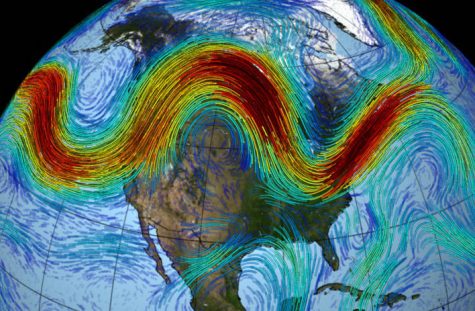Climate Change, El Nino, and Their Impact on Our Weather
February 6, 2019
Chicago and other Midwest cities have been plunged into a near arctic winter, experiencing extremely cold temperatures as low as -60°F. These dangerously low have huge impacts on people, but many don’t understand why this is. The news says lots of things like “polar jet stream” and “low pressure system,” but those mean very little if you don’t know what they mean. In reality, this phenomenon is much more complex than a low pressure system or a dip in the jet stream.
Although there are many possible causes for these record cold temperatures, many scientists assert that global warming could be playing a large role. It seems oxymoronic to say that a warmer globe means colder climates in places, but it is a reasonable assertion. As average air and water temperatures grow around the equator, massive streams of warm air are pushed north. These warm pockets interrupt the polar jet stream, a current of very cold air that circles the north pole, and cause it to sink south.

https://insideclimatenews.org/news/02022018/cold-weather-polar-vortex-jet-stream-explained-global-warming-arctic-ice-climate-change
When it sinks south, it ends up over the United States, this time the Midwest. Because this air is coming off of the Arctic Circle, it is immensely cold, leaving states like Michigan and Minnesota frozen over. If climate scientists are correct, we could be seeing more events like this take place in the future, before the global temperature increase is as noticeable.
The eastern United States isn’t the only place that could be expecting colder temperatures. northern Europe, which gets its mild climate from warm water currents coming off the equator, could experience colder climates. These warm water currents are driven by cold water coming from the Arctic Circle, and if the ice caps melt then this cold water won’t be present to drive the warm water currents north. Without the warm water, the climates of the United Kingdom and other northern countries could turn cold.
On the opposite end of the spectrum, much of the west coast and Rocky Mountains have been having unseasonably high temperatures and little precipitation. This is due to a phenomenon called “El Niño.” El Nino is another phrase people commonly hear have little clue as to what it is. El Niño is when trade winds that usually push cold water to the coasts of Chile and Mexico disappear, leaving warm water in place of the cold water. This warm water means higher air temperatures and usually very little precipitation for North America.
El Niño has may impacts, both direct and indirect. First off, the Pacific fishing industry detrimentally impacted, as fish like the cold, nutrient rich water that is typical of the area. Next, the lack of precipitation over the United States leads to drought and low snowpack levels. The combination of the two makes for bad fire seasons as well as low rivers, both of which have negative economic impacts.
As some experience unseasonably balmy temperatures, others are dealing with temperatures colder than those in Antarctica right now. This wild juxtaposition has become the focus of many discussions, from global warming to preparedness for extreme weather. Either cold or hot, it’s always smart to know what you’re talking about when you start throwing around words like “El Niño” and “polar jet stream.”

